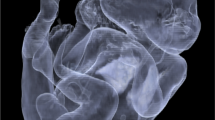We propose an original method of postmortem computed tomography angiography of the body of a deceased newborn. The work is based on the analysis of the results of comprehensive postmortem computed tomography and pathological examination of 30 newborns, who died from congenital malformations. The key to a full-fledged postmortem radiation study using intravascular contrasting of deceased newborns and infants is the presence of vascular catheters established during life, as well as conducting it no earlier than 12 h and no later than 48 h after death. As a contrast agent, we recommend to use an iodine-containing water-soluble radiopaque drug containing at least 250 mg of iodine per 1 ml. The volume of contrast agent is calculated based on body weight, taking into account the general edema syndrome. The introduction of a contrast agent is carried out through vascular catheters in 3 stages in various positions of the body. The analysis of tomograms and 3D-reconstruction of blood vessels using their pseudocoloring allows accurate assessment of the topography of blood vessels with the possibility of separate study of the arterial and venous vessels, and to identify both congenital abnormalities of the heart and blood vessels, and their acquired pathology. CT angiography in some cases is superior to traditional autopsy in the diagnosis of blood vessel pathology. Postmortem CT angiography should be considered as an important stage of postmortem radiology in the structure of comprehensive pathological analysis of newborns and infants.
Similar content being viewed by others
References
Tumanova UN, Lyapin VM, Burov AA, Podurovskaya YuL, Zaretskaya NV, Bychenko VG, Kozlova AV, Shchegolev AI. VACTERL association of newborn: postmortem CT and MRI imaging for autopsy. REJR. 2017;7(2):191-208. Russian.
Tumanova UN, Lyapin VM, Kozlova AV, Bychenko VG, Shchegolev AI. Galen vein aneurysm in a newborn: postmortem MSCT with contrast enhancement of vessels within the autopsy. REJR. 2019;9(2):260-274. Russian.
Tumanova UN, Serova NS, Bichenko VG, Shchegolev AI. Possibilities of using contrast agents in postmortem computed tomography. REJR. 2018;8(3):83-99. Russian.
Tumanova UN, Shuvalova MP, Schegolev AI. Analysis of statistical indicators of congenital anomalies as causes of early neonatal death in the Russian Federation. Ross. Vestn. Perinatol. Pediatr. 2018;63(6):60-67. Russian.
Tumanova UN, Shchegolev AI. Radio-visualization of nonspecific postmortem changes in the cardiovascular system. Sud.-Med. Ekspertiza. 2016;59(5):59-63. Russian.
Tumanova UN, Shchegolev AI. Possibilities and limitations of virutal autopsy in neonatology. REJR. 2017;7(1):20-33. Russian.
Shchegolev AI, Tumanova UN, Shuvalova MP, Frolova OG. Congenital anomalies as a cause stillbirths. Mezhdunarod. Zh. Priklad. Fundament. Issled. 2015;(10-2):263-267. Russian.
Grønvall J, Graem N. Radiography in post-mortem examinations of fetuses and neonates. Findings on plain films and at arteriography. APMIS. 1989;97(3):274-280.
Kulenović A, Dilberović F. Changes in blood vessels in fetuses 4 to 9 months intrauterine life old by postmortem angiography method. Bosn. J. Basic Med. Sci. 2004;4(3):50-54.
Pluchinotta FR, Porayette P, Zaidi AH, Baci J, Teot L, Sanders SP, Prabhu SP. Postmortem imaging in congenital heart disease: preliminary experience. Acta Radiol. 2015;56(10):1264-1272.
Ross S, Spendlove D, Bolliger S, Christe A, Oesterhelweg L, Grabherr S, Thali MJ, Gygax E. Postmortem whole-body CT angiography: evaluation of two contrast media solutions. AJR. Am. J. Roentgenol. 2008;190(5):1380-1389.
Russell GA, Berry PJ. Post mortem radiology in children with congenital heart disease. J. Clin. Pathol. 1988;41(8):830-836.
Shojania KG, Burton EC. The vanishing nonforensic autopsy. N. Engl. J. Med. 2008;358(9):873-875.
Vogel B, Heinemann A, Tzikas A, Poodendaen C, Gulbins H, Reichenspurner H, Püschel K, Vogel H. Post-mortem computed tomography (PMCT) and PMCT-angiography after cardiac surgery. Possibilities and limits. Arch. Med. Sadowej Kryminol. 2013;63(3):155-171.
Votino C, Cannie M, Segers V, Dobrescu O, Dessy H, Gallo V, Cos T, Damry N, Jani J. Virtual autopsy by computed tomographic angiography of the fetal heart: a feasibility study. Ultrasound Obstet. Gynecol. 2012;39(6):679-684.
Author information
Authors and Affiliations
Corresponding author
Additional information
Translated from Byulleten’ Eksperimental’noi Biologii i Meditsiny, Vol. 170, No. 8, pp. 248-255, August, 2020
Rights and permissions
About this article
Cite this article
Tumanova, U.N., Lyapin, V.M., Bychenko, V.G. et al. Postmortem Computed Tomography Angiography of Newborns. Bull Exp Biol Med 170, 268–274 (2020). https://doi.org/10.1007/s10517-020-05049-4
Received:
Published:
Issue Date:
DOI: https://doi.org/10.1007/s10517-020-05049-4




